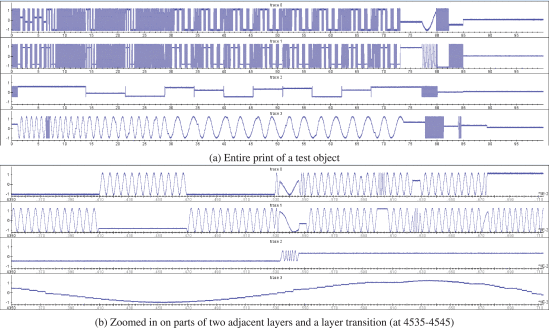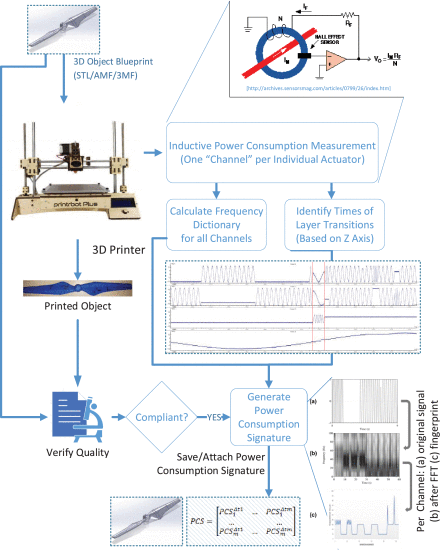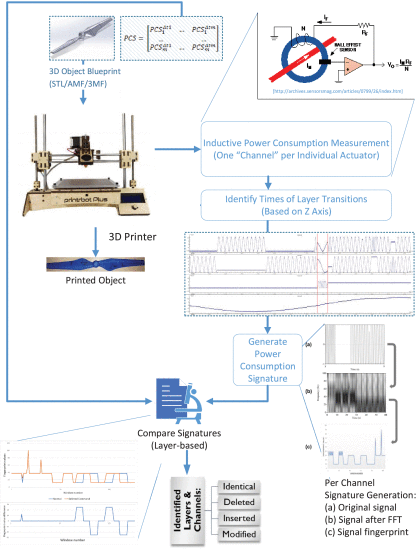Researchers have come together from the US and Israel to study potential threats that could affect additive manufacturing systems. While this does not affect the DIY user fabricating parts and prototypes from the home workshop as much, the authors of ‘Detecting Sabotage Attacks in Additive Manufacturing Using Actuator Power Signatures’ are concerned about ‘AM’s dependence on computerization’ and the need for the protection against sabotage in more complex, industrial settings.
The researchers have created a reliable way to detect sabotage, offering a simple monitoring program that they describe as non-invasive and easy to retrofit for older systems too. Undeniably, there are numerous applications that require protection as research, development and manufacturing progress—especially when they involve safety-critical systems like aerospace components, medical devices, tooling, and more.
As industrial users become further dependent on computerized methods and additive manufacturing, there is ‘growing concern that the AM process can be tampered with.’
If a scenario were to arise where an outside force gained control over AM equipment, a ‘complete sabotage attack’ could occur. This is not a new idea, exactly—and users, manufacturers, and researchers have studied other topics such as 3D printer security threats with drones as examples, new ways to verify integrity of 3D printed objects, and even the possibility of 3D printing threats to nuclear program security. So far, however, the researchers state the need for this study and development of new safety systems as ‘to date, only defensive methods for FDM machines have been verified.’
With the mindset that any computer connected to AM workflow could be ‘compromised,’ the authors explain that analog actuators like stepper motors, however, could not be tampered with via adversarial cyber activity.
Destructive testing results can also validate safety, working with the new detection system comprised of:
- Induction probes
- Oscilloscope
- Monitoring PC for data analysis
For FDM 3D printing, the actuators consist of four motors manipulating movement and extrusion of the printhead. Each one is directly driven, with movement of motors dependent on the electrical current:
“A DC supply (if low-amplitude noise is ignored) indicates the controlled motor is stationary,” explain the researchers. “When sinusoidal current is applied to a stepper motor, each oscillation induces a magnetic field in a set of the motor’s internal coils. This magnetic field draws the geared iron rotor forward by one step. Its rotational speed is controlled by the oscillation frequency. The drive direction can be changed by reversing the current through a set of coils.”
As they modified designs, that meant that changes also were made to currents supplying the actuators—also allowing for any ‘deviations’ to be monitored and detected in comparison. Signals are separated from each motor in the detection system, as they can examine each motor separately.
‘Discrete discretion’ is used regarding each printed layer, to be identified whether they have been added, deleted, or changed; and in fact, layer transitions must be a focus as they can be used by any possible adversaries as a time to manipulate filament negatively or launch other AM attacks. Ultimately, however, the researchers realized that new parameters are necessary for monitoring layer transitions because of the limited time period available:
“Under current settings, only two or three consecutive windows for each layer transition will be produced. This is insufficient to reliably distinguish between malicious modifications and stochastic anomalies.”
Signature generation and verification play a central role in the new system, allowing users to confirm that parts have not been tampered with as the master signature is examined in comparison to signatures ‘generated from the current traces of the investigated process.’
Overall, this new method can detect sabotage, along with ‘void-insertion attacks.’ Any changes to G-code movement commands are noticed one hundred percent of the time within this new system, to include the X and Y motors, and Z movements.
“In our future work, we plan to overcome the identified limitations, including the restriction to open-loop AM systems, and accounting for the gradual accumulation of deviations. We will also test the method against other FDM printers, and adapt it for other printing technologies, such as Powder Bed Fusion and Directed Energy Deposition,” concluded the researchers. “The demonstrated anomaly detection performance and the potential applicability to metal AM systems makes the proposed approach an important milestone to ensure AM security in safety-critical systems.”
Source: 3DPrintBoard.com





